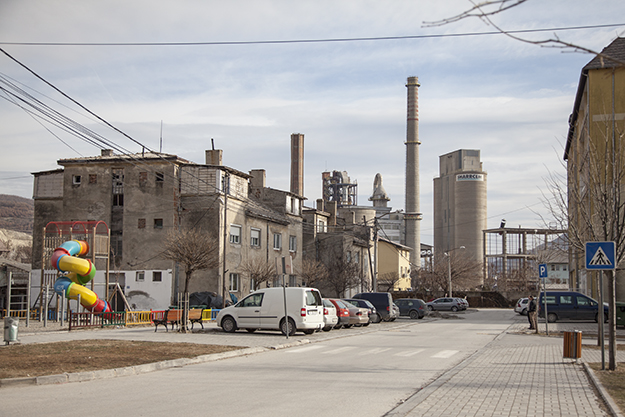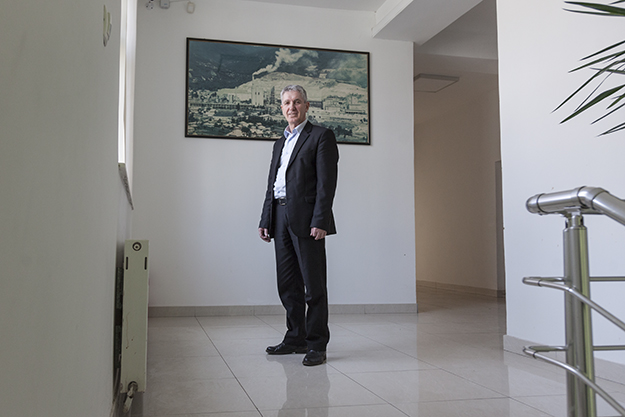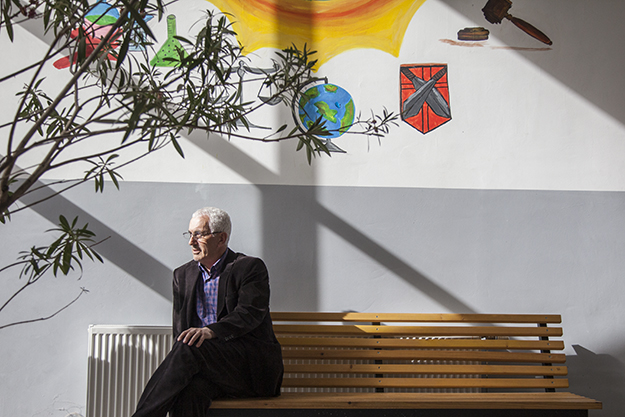First grade children in the morning shift at Ilaz Thaçi school sit around tables in groups of four with their ‘Abetare’ ABC books open in front of them. As they focus hard on practising writing the new letters they learn, the walls of the classroom, covered in colorful drawings, are in stark contrast to the view through the large windows.
Looking out onto a cool winter’s day, the scene is dominated by the big chimney of the Sharrcem cement plant in the center of Han i Elezit, around 500 meters from the school.
“It was once famous in former Yugoslavia,” says Ilaz Thaçi’s director, Nazim Laçi, his tone hinting simultaneously at pride and disappointment. “It was Trepça for metals, Obiliq for electricity and Sharrcem for cement.”
In fact, Han i Elezit, as a town, owes its existence to Sharrcem. Built in 1936, the factory acted as a trigger for people to gradually move close by from the surrounding villages in the Sharr and Karadaku mountains in order to find employment, ultimately leading to the establishment of the present-day settlement.

Hani i Elezit was built up around a cement factory, but it’s unknown how much this industrial past is casting a shadow over the health of the next generation. Photo: Majlinda Hoxha / K2.0.
While the factory has made the tiny town in the Kosovo-Macedonia border hills well known over the decades, it has also done what factories often do — pollute the air for citizens living nearby, and create a hazardous environment for pupils whose school is in its shadow. Sharrcem is repeatedly reported to be one of the biggest polluters in Kosovo, together with the coal-based power plants in Obiliq, Ferronikeli iron and nickel factory in Drenas and the Trepça industrial complex in the north of the country.
Despite the extent of damage to young children caused by pollution being a much discussed topic in Kosovo, the Ministry of Education is unable to provide any data on which schools are in the close vicinity of factories or other heavy polluters, and publicly available monitoring of air conditions at schools tend to come only through ad hoc initiatives by civil society organizations.
Menduh Vlashi, director of the Education Department at the Municipality of Han i Elezit, says that the Ministry of Environment and Urban Planning has carried out air monitoring at the school but he is highly skeptical of the results. Vlashi says that the Ministry officials placed an air monitoring controller in the school yard and have tried to assure the Municipality that the monitoring results suggest that the air pollution is within acceptable standards.
“I told the Ministry not to show me the report,” he says. “I told them that the pollution is so evident that you can leave the car at the border, go to Skopje and when you come back you need to wash it with vinegar because you cannot get it clean otherwise.”
He says that he is a chemist by profession and that he can smell the odor of gases such as sulfur dioxide and carbon monoxide — gases associated with increased respiratory problems and disease, from difficulty in breathing to premature death.

Menduh Vlashi, the Municipality of Han i Elezit’s director of education, says that based on his experience of living in the town he does not believe that the air quality is an acceptable standard. Photo: Majlinda Hoxha / K2.0.
Vlashi says that Sharrcem is not good for the school, the children or any citizen living in Han i Elezit. But as the town became populated after Sharrcem was built, he believes citizens are more reluctant to speak out about the air pollution in their town.
Indeed, many residents, including the school’s director, say that certain measures taken over the years mean that conditions are better than they once were, with some locals recalling a time when their red roof tiles permanently turned white due to the large amount of dust emitted out of the vast chimney.
Other local environmental pollutants have also been restricted in recent years. It was Sharr-Salloniti, they say, a factory closed after the war, that caused them to experience the harshest consequences of life inside an industrialized zone.
The factory used to produce roof tiles containing asbestos, a material widely used for decades in thousands of products from insulation to construction materials. Concerns over asbestos-related illnesses became an issue during the 20th century, and by the ’90s many countries began restricting and outright banning its use, with researchers pointing out how the inhalation of microscopic fibers released in the air was leading to serious health problems, including lung cancer.
Citizens in Han i Elezit can still easily point out hundreds of parts and pieces containing asbestos, from water and sanitation pipes to decorative flower vases; media reports suggest that around 100 former employees of Sharr-Salloniti have died from exposure to the hazardous material, while many others have been diagnosed with various diseases and health issues due to its widespread presence in the area as institutions have failed to completely eliminate it.
While it is widely known that use of the substance is particularly widespread in the area, the school’s director says he’s sure that the Ilaz Thaçi school building and its surroundings are asbestos free — there is, however, no available research to confirm this one way or the other.

Nazim Laçi, director of the Ilaz Thaçi school in Han i Elezit, doesn’t think asbestos is a problem at his school, although no information is available to support his confidence. Photo: Majlinda Hoxha / K2.0.
In fact, more widely, there is no study or database of schools whose infrastructure may have potentially dangerous effects on the health and well-being of pupils and teachers.
Rinor Qehaja, from education monitoring organization EdGuard Institute, says that such concerns could range from old neglected facilities that have developed problems with mold and damp to schools with no green spaces in which children can exercise or play.
“Despite there being no empirical data for something like this, a few visits to schools around the country are sufficient to understand this,” he says. “The problem lies in the fact that these concerns pose a risk to the health of children and, unfortunately, this is completely overlooked.”
Qehaja is just one of a number of education experts who point out that investment in school building has long been more of a political investment than a long-term interest in the well-being of young people. He argues that the construction of schools is not based on statistical projections related to population density.
“Investing in schools as ‘space’ represents a mindset that has direct implications for quality."
Rinor Qehaja, EdGuard Institute
Demographic trends since the ’99 war in Kosovo have seen significant rural flight, with people tending to move toward bigger urban centers. One of the effects has been virtually empty schools in some rural areas, and badly overcrowded schools in cities, with some requiring three shifts to accommodate all of the students. Meanwhile, the number of pupils engaged in pre-university education in Kosovo was recently reported to have decreased by 90,000 in the past decade.
Kosovo’s current Education Strategy foresees the construction of 25 new primary and secondary schools in the period 2017-21, however recent research by K2.0 found little evidence that lessons have been learned from a historical lack of planning or coordination when it comes to building new education facilities. Almost halfway into the current Education Strategy’s implementation period, the School Map Investment Plan — the document upon which the need for new schools is supposed to be based — has still not been finalized, raising questions about the basis upon which the decision to build two dozen new schools was made.
“Investing in schools as ‘space’ represents a mindset that has direct implications for quality — our schools still lack the accompanying infrastructure, kitchens, lockers, libraries and sports halls,” Qehaja says, adding that the “urban chaos” of many municipalities means the only criterion for selecting the locations in which to build new facilities is where space is available, and that environmental factors remain “peripheral.”
“Many schools are built alongside highways, directly endangering children’s safety,” he says
Replacing the coal
One of the biggest concerns over the years for environmental and health campaigners when it comes to health and safety at schools has been the widespread use of coal for heating systems.
Burning coal, both in the two Yugoslav-era power plants at Obiliq and within homes and businesses, has long been a relatively cheap source of energy for Kosovars, but it has come at a tremendous cost to the country’s air quality. During the winter months, many of Kosovo’s cities and municipalities often wake up under a thick blanket of black smog, and medical facilities see a significant increase in respiratory complaints during the most polluted days.
Coal has also long been used as a primary source of heating for many schools all over Kosovo, with the Ministry of Education stating that until recently this was the primary heating source for more than 200 of the country’s schools.
Rinora Gojani from Balkan Green Foundation, an organization that advocates for regional sustainable development, says that the topic of inside air pollution has rarely been discussed in wider society, despite children and adolescents being particularly vulnerable to its effects. “Air pollution, especially indoor air pollution that is exacerbated by coal smoke, has a greater impact on children and young people who are very sensitive due to their age and it has long-term consequences for them,” she says.
With increasing concern over air quality in recent years, officials at the Ministry of Environment told K2.0 that they had had an ongoing discussion with the Ministry of Education in order to try to find a solution for the extensive use of coal in schools.
Each of the 21 municipalities that answered claimed that coal has been substituted for wood at all of their schools.
It was only in September last year that the Minister of Education, Shyqri Bytyqi, took the decision to prevent the use of coal at any pre-university institution, affecting 954 primary schools and 122 secondary schools. At the time, he stated that it was the responsibility of municipalities to implement the decision and to find alternative sources for heating in order to protect the environment.
“Coal is one of the main polluters in Kosovo and the prohibition of its use on heating in schools and public buildings is a delayed but necessary measure,” says Dardan Abazi from independent think tank INDEP. “Coal burning causes harmful emissions to the environment and causes respiratory disease as a result many pollutants released such as carbon monoxide and carbon dioxide.”
Using the legal right to access public documents, in November 2018, K2.0 sent a request to the Ministry of Education to have access to any reports or data analysing the effects of coal pollution on schools that it had used when making its decision to ban its use, and asking what monitoring was being conducted to ensure municipalities were using alternatives.
The Ministry of Education didn’t provide any data or report, but Valmir Gashi, one of the minister’s political advisers, replied that the decision to stop the burning of coal at schools came at the request of the Ministry of Environment.
K2.0 also contacted all of the 28 municipalities whose education structures operate within Kosovo’s system — the remaining municipalities still operate within Serbia’s education system —- in order to find out if the decision has been implemented. Each of the 21 municipalities that answered claimed that coal has been substituted for wood at all of their schools.
A number of municipalities noted that replacing coal with more expensive wood has added an extra burden to their education budget. For example the Municipality of Drenas told K2.0 that in order to provide alternate heating, the Municipality needed to cut other expenses related to schools. It also stated that, due to the requirement for a new procurement process for purchasing the wood, the turning on of the school’s heating was delayed at the start of winter.
Asked what support was being provided by the Ministry of Education to manage the transition away from coal, Gashi responded: “The Ministry is ready to support municipalities in their requests, but it is the responsibility of municipalities to ask for better heating alternatives and to do the monitoring as to whether the new alternative heating is functioning at schools.”
Meanwhile, despite the progress in banning the worst polluter from school interiors, environmental activists argue that while banning the burning of coal is a step in the right direction, burning wood is far from a durable solution.
“Replacement of coal fuel by wood mass is much better for improving air quality, but pollution is not completely eliminated and there are still emissions of particulate pollutants, especially of PM 2.5 particles,” says Gojani, referring to harmful microparticles, whose inhalation are linked to cardiopulmonary and respiratory diseases.
“Replacing coal with wood does not represent progress, and in that sense I do not think that wood is the future.”
Dardan Abazi, INDEP
She adds that the the use of wood for schools will add to the existing issue of illegal deforestation as it will affect the increase in demand for wood. Thousands of hectares of Kosovo’s forests are already being decimated due to widespread illegal tree felling, with devastating effects on the environment; amongst other things, forests are essential for helping to purify air, as well as preventing soil erosion and helping to mitigate climate change.
Abazi says that burning wood emits less carbon dioxide than coal but that the health impacts are similar, while also emphasizing that the use of wood for heating has caused alarming deforestation in some areas of Kosovo. “In our context [in Kosovo], replacing coal with wood does not represent progress, and in that sense I do not think that wood is the future,” he says.
Additionally, while the Ministries of Education and Environment have focused on the long discussed hazardous coal, little attention has been paid to the use of oil. Just like many households and work spaces that aren’t connected to municipal central heating systems, many schools use oil as their main source of heating.
“The use of oil for heating should be discouraged and prohibited because it damages the quality of the air, particularly outside the school facility.”
Rinora Gojani, Balkan Green Foundation
Abazi and Gojani argue that, in the long run, the burning of oil is dangerous because it emits gases that can damage both the environment and health and because the quality of oil sold in kosovo is poorly monitored.
“The use of oil for heating should be discouraged and prohibited because it damages the quality of the air, particularly outside the school facility,” Gojani says. “Although internal air pollution [from oil-based heating systems] is much lower than with coal heating, it cannot be completely excluded and it depends on the age and efficiency of the technology used for heating.”
The Municipality of Peja told K2.0 that while some of its schools use wood for their heating systems, others use oil, while the Municipalities of Kaçanik and Fushë Kosovë also both reported that one kindergarten in each of their municipalities uses oil.
But it seems that oil is most commonly used for heating in the capital, with 33 educational institutions in Prishtina reported to be using oil as the main source of heating in December 2018; in 2014, lessons were stopped in 43 educational institutions in Prishtina, as testing on oil showed a high level of sulphide in the oil used by the schools.
Gojani and Abazi both point out that alternative solutions are available that are more environmentally friendly, more efficient and better for people’s health than the heating systems currently being used in schools.
Gojani proposes the installation of electric heating, with new and modern equipment such as thermal pumps that make maximum use of energy.
Abazi, meanwhile, says that the answers lie in a combination of factors. “The first is about investing in energy efficiency and internal energy management systems in schools,” he says, before suggesting that schools should simultaneously invest in renewable energy systems that would also help raise environmental awareness for new generations.
“Solar panels would be able to generate electricity that would be fed into the network during very sunny months and returned to the school in the months when electricity for heating is needed,” he says. “In addition, schools can install geothermal heating systems that are extremely good for the environment and health, and they reduce costs.”K
Feature image: Majlinda Hoxha / K2.0.
This article has been produced with the assistance of the European Union. The contents of this publication are the sole responsibility of Kosovo 2.0 and can in no way be taken to reflect the views of the European Union or BIRN and AJK.




